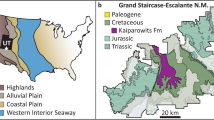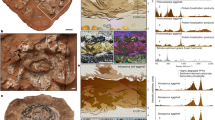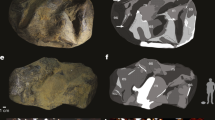Abstract
Birds are the only living amniotes with coloured eggs1,2,3,4, which have long been considered to be an avian innovation1,3. A recent study has demonstrated the presence of both red-brown protoporphyrin IX and blue-green biliverdin5—the pigments responsible for all the variation in avian egg colour—in fossilized eggshell of a nonavian dinosaur6. This raises the fundamental question of whether modern birds inherited egg colour from their nonavian dinosaur ancestors, or whether egg colour evolved independently multiple times. Here we present a phylogenetic assessment of egg colour in nonavian dinosaurs. We applied high-resolution Raman microspectroscopy to eggshells that represent all of the major clades of dinosaurs, and found that egg colour pigments were preserved in all eumaniraptorans: egg colour had a single evolutionary origin in nonavian theropod dinosaurs. The absence of colour in ornithischian and sauropod eggs represents a true signal rather than a taphonomic artefact. Pigment surface maps revealed that nonavian eumaniraptoran eggs were spotted and speckled, and colour pattern diversity in these eggs approaches that in extant birds, which indicates that reproductive behaviours in nonavian dinosaurs were far more complex than previously known3. Depth profiles demonstrated identical mechanisms of pigment deposition in nonavian and avian dinosaur eggs. Birds were not the first amniotes to produce coloured eggs: as with many other characteristics7,8 this is an attribute that evolved deep within the dinosaur tree and long before the spectacular radiation of modern birds.
This is a preview of subscription content, access via your institution
Access options
Access Nature and 54 other Nature Portfolio journals
Get Nature+, our best-value online-access subscription
$29.99 / 30 days
cancel any time
Subscribe to this journal
Receive 51 print issues and online access
$199.00 per year
only $3.90 per issue
Buy this article
- Purchase on Springer Link
- Instant access to full article PDF
Prices may be subject to local taxes which are calculated during checkout


Similar content being viewed by others
Data availability
The authors declare that all Raman data supporting the findings of this study are available within the paper (pigment maps and depth profiles), and its Supplementary Information and Source Data.
References
Kilner, R. M. The evolution of egg colour and patterning in birds. Biol. Rev. Camb. Philos. Soc. 81, 383–406 (2006).
Cherry, M. I. & Gosler, A. G. Avian eggshell coloration: new perspectives on adaptive explanations. Biol. J. Linn. Soc. 100, 753–762 (2010).
Cassey, P. et al. Why are birds’ eggs colourful? Eggshell pigments co-vary with life-history and nesting ecology among British breeding non-passerine birds. Biol. J. Linn. Soc. 106, 657–672 (2012).
Packard, M. J. & Seymour, R. S. in Amniote Origins: Completing the Transition to Land (eds Sumida, S. S. & Martin, K. L. M.) Ch. 8, 265–290 (Academic, San Diego, 1997).
Kennedy, G. Y. & Vevers, H. G. A survey of avian eggshell pigments. Comp. Biochem. Physiol. B 55, 117–123 (1976).
Wiemann, J. et al. Dinosaur origin of egg color: oviraptors laid blue-green eggs. PeerJ 5, e3706 (2017).
Norell, M. A., Clark, J. M., Chiappe, L. M. & Dashzeveg, D. A nesting dinosaur. Nature 378, 774–776 (1995).
Turner, A. H., Makovicky, P. J., & Norell, M. A. A Review of dromaeosaurid systematics and paravian phylogeny. Bull. Am. Mus. Nat. Hist. 371, 1–206 (2012).
Stoddard, M. C. & Prum, R. O. How colorful are birds? Evolution of the avian plumage color gamut. Behav. Ecol. 22, 1042–1052 (2011).
Komdeur, J. & Kats, R. K. Predation risk affects trade-off between nest guarding and foraging in Seychelles warblers. Behav. Ecol. 10, 648–658 (1999).
Gillis, H., Gauffre, B., Huot, R. & Bretagnolle, V. Vegetation height and egg coloration differentially affect predation rate and overheating risk: an experimental test mimicking a ground-nesting bird. Can. J. Zool. 90, 694–703 (2012).
Hewitson, W. C. Eggs of British Birds (John Van Voorst, London, 1846).
Wallace, A. R. Darwinism: An Exposition of the Theory of Natural Selection with Some of its Applications (Macmillan, London, 1890).
Stoddard, M. C. et al. Camouflage and clutch survival in plovers and terns. Sci. Rep. 6, 32059 (2016).
Newton, A. V. A Dictionary of Birds (A&C Black, London, 1896).
Ishikawa, S. et al. Photodynamic antimicrobial activity of avian eggshell pigments. FEBS Lett. 584, 770–774 (2010).
Lahti, D. Population differentiation and rapid evolution of egg colour in accordance with solar radiation. Auk 125, 796–802 (2008).
Gosler, A. G., Higham, J. P. & Reynolds, S. J. Why are birds’ eggs speckled? Ecol. Lett. 8, 1105–1113 (2005).
Ryter, S. W. & Tyrrell, R. M. The heme synthesis and degradation pathways: role in oxidant sensitivity. Heme oxygenase has both pro- and antioxidant properties. Free Radic. Biol. Med. 28, 289–309 (2000).
Falk, J. E. Porphyrins and Metalloporphyrins (Elsevier, Amsterdam, 1964).
Gorchein, A., Lim, C. K. & Cassey, P. Extraction and analysis of colourful eggshell pigments using HPLC and HPLC/electrospray ionization tandem mass spectrometry. Biomed. Chromatogr. 23, 602–606 (2009).
Milgrom, L. R. & Warren, M. J. in The Colours of Life: An Introduction to the Chemistry of Porphyrins and Related Compounds (ed. Milgrom, L. R.) Ch. 1–5, 1–175 (Oxford Univ. Press, Oxford, 1997).
Wang, X. T. et al. Comparison of the total amount of eggshell pigments in Dongxiang brown-shelled eggs and Dongxiang blue-shelled eggs. Poult. Sci. 88, 1735–1739 (2009).
Igic, B. et al. Detecting pigments from colourful eggshells of extinct birds. Chemoecology 20, 43–48 (2010).
Nys, Y., Gautron, J., Garcia-Ruiz, J. M. & Hincke, M. T. Avian eggshell mineralization: biochemical and functional characterization of matrix proteins. C. R. Palevol 3, 549–562 (2004).
Wiemann, J. et al. Fossilization transforms proteins into N-heterocyclic polymers. Nat. Commun. https://doi.org/10.1038/s41467-018-07013-3 (2018).
Varricchio, D. J. & Jackson, F. D. Reproduction in Mesozoic birds and evolution of the modern avian reproductive mode. Auk 133, 654–684 (2016).
Sereno, P. C. The evolution of dinosaurs. Science 284, 2137–2147 (1999).
Pisani, D., Yates, A. M., Langer, M. C. & Benton, M. J. A genus-level supertree of the Dinosauria. Proc. R. Soc. Lond. B 269, 915–921 (2002).
Carpenter, K. et al. (eds) Dinosaur Eggs and Babies (Cambridge Univ. Press, Cambridge, 1996).
Mikhailov, K. E., Bray, E. S. & Hirsch, K. F. Parataxonomy of fossil egg remains (Veterovata): principles and applications. J. Vertebr. Paleontol. 16, 763–769 (1996).
Thomas, D. B. et al. Analysing avian eggshell pigments with Raman spectroscopy. J. Exp. Biol. 218, 2670–2674 (2015).
Acknowledgements
We thank D. E. G. Briggs for advice and assistance with the manuscript. M. Fabbri, N. Mongiardino Koch, J. Gauthier, K. Zykowski and R. Prum made helpful suggestions. Y.-N. Cheng, Y.-F. Shiao, X. Wu, T. Töpfer, P. M. Sander and K. Zykowski provided eggshell specimens. This research was supported by the Steven Cohen Award of the Society of Vertebrate Paleontology (J.W.), the Macaulay Family Endowment (M.A.N.) and the Division of Paleontology, American Museum of Natural History.
Reviewer information
Nature thanks D. Zelenitsky and the other anonymous reviewer(s) for their contribution to the peer review of this work.
Author information
Authors and Affiliations
Contributions
J.W., T.-R.Y. and M.A.N. designed the research. J.W. designed and performed the experiments. M.A.N. and T.-R.Y. contributed materials. J.W. created the figures. J.W. and M.A.N. wrote the manuscript, which was reviewed by all authors.
Corresponding author
Ethics declarations
Competing interests
The authors declare no competing interests.
Additional information
Publisher’s note: Springer Nature remains neutral with regard to jurisdictional claims in published maps and institutional affiliations.
Extended data figures and tables
Extended Data Fig. 1 Spectral plots that validate the Raman bands indicative of biliverdin and protoporphyrin IX relative to PFPs, based on three representative samples.
Spectral plots are 200–1,600 cm−1 ± 2 cm−1, from 6 accumulations; spectra are baselined and normalized. Each spectrum was repeated three times independently, and yielded similar results. The lowermost spectral plot depicts blue spectra for biliverdin (from D. novaehollandiae eggshell), red spectra for protoporphyrin IX (from G. domesticus) and brown spectra for fossil proteinaceous soft tissue (from A. fragilis bone; see previous study26). The uppermost dark-brown spectra represent an in situ measurement for the H. huangi (NMNS CYN-2004-DINO-05) eggshell that is known to preserve both pigments (biliverdin and protoporphyrin IX). Blue asterisks label bands of biliverdin that differ from PFP; red asterisks label bands of protoporphyrin IX that are absent in fossil soft-tissue remains. Overall, 22 Raman bands are identified that can be generated only by original unaltered pigments, and not by PFPs that are simultaneously present.
Extended Data Fig. 2 Spectral close-ups of the pigment fingerprint region for nineteen archosaur eggshells.
Spectra are at 1,500–1,700 cm−1 ± 2 cm−1 from 6 accumulations, and are baselined and normalized. a, Unpigmented eggshell samples (Fig. 1). b, Eggshell samples containing only protoporphyrin IX. Red bands label the set of bands that is diagnostic for protoporphyrin IX eggshell pigment. c, Biliverdin-rich eggshell samples. Blue bands label the set of bands that is diagnostic for biliverdin eggshell pigment. Note the characteristic spectral differences between unpigmented and pigmented eggshell samples. 1, A. mississipiensis; 2, M. peeblesorum (YPM VP PU 023464); 3, South American saltasaurid; 4, French titanosaurid; 5, G. domesticus; 6, Chinese troodontid; 7, Mongolian microtroodontid (MAE 14-40); 8, P. rothschildi; 9, Mongolian enantiornithine; 10, Mongolian troodontid (AMNH FARB 6631); 11, Mongolian troodontid (IGM 100/1003); 12, D. noveahollandiae; 13, R. americana; 14, D. antirrhopus; 15, Mongolian microtroodontid (IGM 100/1323); 16, H. huangi.
Extended Data Fig. 3 Eggshell net enrichment plots resulting from subtraction of the sediment spectral functions from their corresponding eggshell spectral functions.
Spectra are at 1,500–1,700 cm−1 ± 2 cm−1 from 6 accumulations, and are base-lined and normalized. Positive values indicate a net enrichment of fossil eggshells in organic compounds relative to their sediment surroundings, whereas negative values indicate a net depletion. Red bands are diagnostic for protoporphyrin IX, and blue bands are diagnostic for biliverdin. a, M. peeblesorum (YPM VP PU 023464). b, South American saltasaurid. c, French titanosaurid. d, H. huangi. e, Mongolian microtroodontid (IGM 100/1323). f, Mongolian microtroodontid (MAE 14-40). g, North American troodontid. h, Mongolian troodontid (AMNH FARB 6631). i, Mongolian troodontid (IGM 100/1003). j, Chinese troodontid. k, D. antirrhopus. l, Mongolian enantiornithine.
Extended Data Fig. 4 PCA of spectral data.
a, Whole spectra-based PCA of all modern (n = 4 biologically independent samples) and fossil (n = 14 biologically independent samples) eggshell and sediment samples (n = 12 independent samples). Sediment samples cluster together (green), and do not overlap the cluster of eggshell samples (grey-to-yellow). Eggshell biomolecules and sediment organics are distinct. Within the eggshell cluster, extant material is separated from fossil material. The proximity of unpigmented, protoporphyrin IX-bearing and biliverdin-rich extant eggshell material emphasizes that the taphonomic signal overprints the pigment signal at the level of a whole spectrum-based PCA. PC1 (73.116%) and PC2 (10.977%) are characterized by high support values and explain most of the variation in the eggshell and sediment sample set. b, PCA based on the pigment fingerprint region (1,500–1,650 cm−1 ± 2 cm−1) of protoporphyrin IX and biliverdin in fossil eggshell material (n = 12 biologically independent samples). The exclusion of fresh and ‘subfossil’ (P. rothschildi and ornithoid ratite) eggshell material and the extraction of the pigment fingerprint region enable a chemo-space separation based on the eggshell pigment signal. Pigmented fossil eggshells form a cluster (yellow) that is separated from the cluster (grey) of unpigmented fossil eggshells (Extended Data Fig. 5). The pigment fingerprint region includes—besides protoporphyrin IX and biliverdin—structurally similar PFPs as well as pigment fossilization products, which account for the distribution of samples within each cluster of fossil eggshells (pigmented and unpigmented). PC1 represents sample variation based on pigment type, concentration and PFP contents, and PC2 separates samples based on the presence or absence of eggshell pigments (Extended Data Fig. 5).
Extended Data Fig. 5 Loadings plots for principal component axes 1–3.
These loading plots are for the PCA shown in Extended Data Fig. 4. a, Loadings per wavelength and functional group for PC1 (57.118%). Negative loadings are associated with C–N functions, while positive loadings are associated with C–O functions. PC1 separates samples in the chemospace based on pigment type (protoporphyrin IX ratio of C–N to C=O) > biliverdin (ratio of C–N to C=O)), concentration, and PFP contents. b, Loadings per wavelength and functional group for PC2 (23.841%). Negative loadings are associated with prominent PFP bands, whereas positive loadings are associated with eggshell pigments. Thus, PC2 separates samples in the chemo-space on the basis of the presence or absence of eggshell pigments. c, Loadings per wavelength and functional group for PC3 (9.258%).
Extended Data Fig. 6 High-resolution Raman point measurements of eggshell sediment samples.
n = 12 independent samples. Measurement parameters are identical to those used to process eggshell samples, to guarantee comparability (300–2,000 cm−1 ± 2 cm−1, 6 accumulatations, 20 s of exposure, base-lined and normalized). Each sediment measurement was repeated three times independently and yielded similar results. The coloured dots label potential pigment-band positions (biliverdin, blue; protoporphyrin IX red). For comparison, a pigment-positive spectrum of H. huangi eggshell (1) is provided at the bottom, followed by sediments associated with M. peeblesorum (YPM VP PU 023464) (2); M. peeblesorum (YPM PU 22523) (3); South American saltasaurid (4); French titanosaurid (5); H. huangi (6); Mongolian microtroodontid (7); North American troodontid (8); Chinese troodontid (9); Mongolian troodontid (10); D. antirrhopus (11); Mongolian enantiornithine (12); and North American ornithoid ratite (13) eggshells. None of the sediments contains substantial amounts of eggshell pigments.
Supplementary information
Supplementary Information
This file contains Supplementary Information, including Supplementary Figures 1-5 and Supplementary Tables 1-2 and additional references.
Rights and permissions
About this article
Cite this article
Wiemann, J., Yang, TR. & Norell, M.A. Dinosaur egg colour had a single evolutionary origin. Nature 563, 555–558 (2018). https://doi.org/10.1038/s41586-018-0646-5
Received:
Accepted:
Published:
Issue Date:
DOI: https://doi.org/10.1038/s41586-018-0646-5
Keywords
This article is cited by
-
Plumage and eggshell colouration covary with the level of sex-specific parental contributions to nest building in birds
The Science of Nature (2024)
-
Coloniality and development impact intraclutch consistency of avian eggs: a comparative analysis of the individual repeatability of eggshell size and shape metrics
The Science of Nature (2023)
-
What do their footprints tell us? Many questions and some answers about the life of non-avian dinosaurs
Journal of Iberian Geology (2023)
-
Biogeographic history, egg colouration, and habitat selection in Turdus thrushes (Aves: Turdidae)
Biologia Futura (2023)
-
Apatite in Hamipterus tianshanensis eggshell: advances in understanding the structure of pterosaur eggs by Raman spectroscopy
Heritage Science (2022)
Comments
By submitting a comment you agree to abide by our Terms and Community Guidelines. If you find something abusive or that does not comply with our terms or guidelines please flag it as inappropriate.



